Product-led growth is a strategy that uses the product as a channel to drive organizational KPIs, such as revenue, engagement, and reach. An increasing number of SaaS businesses are using it as their go-to growth strategy; it is often more sustainable and scalable than other industry growth models.
Successful product-led growth benefits include:
A customer-centric product, smoother UX, and better user value
Fast, autonomous customer acquisition
Higher retention & lower churn rates
Lower customer acquisition costs (CAC)
Better cross-team collaborations & holistic product development
Improved customer satisfaction scores (CSAT) and net promoter scores (NPS)
More efficient and scalable growth
Ready to break down silos, learn new frameworks, and grow your company exponentially? That’s what the product-led growth model is all about—putting your product at the heart of everything your company does.
In this article, we’ll take you through the fundamental theories, examples, and frameworks that surround product-led growth so that you can walk away with a toolkit of resources to implement in your company.
Product-led growth means that your business grows without investing tens of thousands of dollars on paid advertising or have your sales team constantly calling leads. Your product becomes the key driver of acquisition, monetization, and retention.
Find out below how product leaders from Drift, ActiveCampaign, User Interviews, HubSpot, Retainable, Braze, and Heap define a product-led growth model.
How can you spot a product-led company in the wild? These companies usually have a freemium model, a laser focus on UX, and a strong community of product fans. Their products slide right into your tech stack and become essential quickly.
Product-led, sales-led, and marketing-led growth strategies are all different. We explain how to differentiate between them and how to confidently choose one that will work for your company.
Key frameworks used for PLG include Growth Loops, the Hook Model, the BJ Fogg Behavior Model, and the RICE prioritization framework. Check out the real-life examples and learn how to apply each.
The journey to PLG starts with executive alignment that product-led growth is the right strategy for you.
Once you get internal buy-in, you can proceed to the key steps of PLG implementation: set PLG as a goal, define roles and responsibilities (check out below who makes a PLG dream team), implement product analytics, run in-app experiments for improvement, and then measure, learn, and repeat.
To learn even more, check out our favorite product-led resources, which include ProductLed, OpenView, Growth.design, and more!
What is a product-led growth model?
Product-led growth (PLG) is a tricky one to pin down as there are so many things that make it unique. To sum it up in a few words…
“Product-led growth (PLG) is a strategy that focuses on product, UX, and users to drive revenue via self-service, viral loops, lower barriers to entry, and user-generated content.”
– Pulkit Agrawal, CEO and Co-founder @ Chameleon
While you're here, join Chameleon’s CEO and Co-Founder, Pulkit Agrawal for a glimpse into the future of tech and a peek at the Chameleon roadmap.
Watch the full webinar to get the full low-down on how you should be doing product-led growth.👇
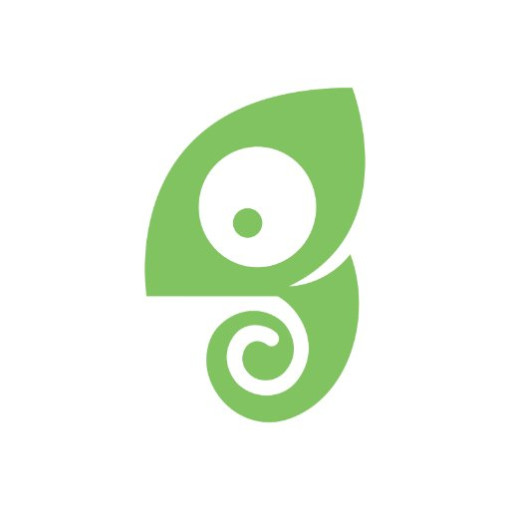
🎬 Webinar: Tea Leaves and Tech: What's in Store for 2024
Learn the latest tactics and trends for product adoption success.
What are some familiar product-led companies?
How do you spot a product-led company in the wild? There are a few key characteristics that you will notice:
Usually, they’ll have a freemium model (“start free today!”)
Low barrier-to-entry (self-serve vs. forced sales demo)
Laser-focused on user experience (expect glowing reviews)
Expansion based upon their existing network (they have a fan base that refers to others)
Habit-building (they slide right into your tech stack and become essential real quick)
They solve a real need in a lower-friction way than competitors (butter smooth)
Seen a few that match these requirements? Here are some quick-fire examples of product-led companies and how they have leveraged PLG to power their acquisition:
Dropbox in 2008. Even the MVP was the best product at the time + free plan + viral invite loop
GitHub in 2013. Built forking, pull requests, and other modern must-haves on top of Linux creator Linus Torvalds’ git, a developer collaboration tool that was already widely adopted. Attracted important open source projects and grew awareness through community and Google-indexed public code repositories
Drift in 2015. Reducing barriers to entry (free plan, try without devs) + an increasingly powerful feature set to make Drift indispensable after install
Slack in 2016. Directed marketing power towards triggering a fundamental shift in the way teams viewed internal communication. The free plan made it possible for teams to adopt without getting buy-in from the C-suite; the introduction of free plan limitations and best-in-class collaboration features/integrations made it stick and grow virally within organizations
Trello in 2018. Leveraged its huge existing user base (with many business prospects on the free plan) + introduction of Business and Enterprise plans + reduction of free features (10 board limit) + expansion of premium features (automation, integrations).
A short history of product-led growth
In the beginning, tech product growth was mainly sales and marketing-led.
Selling IBM PCs or copies of Microsoft Office was made possible with armies of regional reps, big-budget print ads, and flashy billboards. A focus on sales and marketing was all that the industry’s heavy hitters knew, and they sold more on brand than features: the name on the box was much more important than its contents.
Things have come a long way since the early 80s, and technology has become much cheaper to produce, deploy, and distribute.
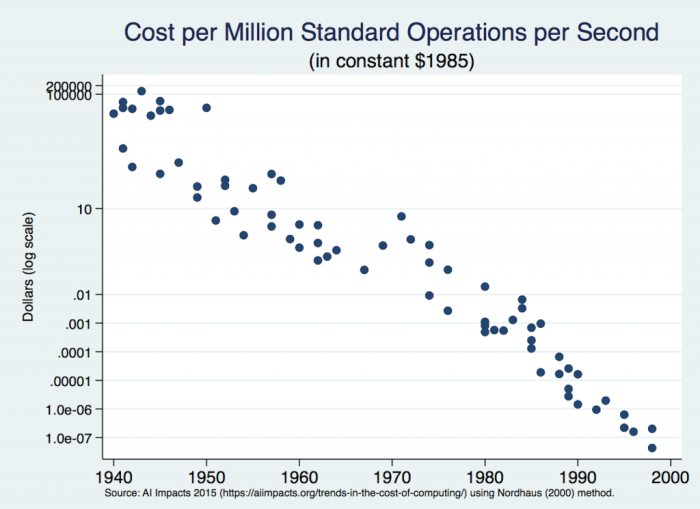
As computing power, internet speed, and programming language efficiency increased, it became possible for bedroom hackers to pose a real threat to the incumbents of yore.
In fact, smaller teams found freedom in being able to iterate quicker than their enterprise counterparts, and with the internet making global distribution trivial, products started to compete based on their intrinsic value rather than their sales/marketing firepower.
Salesforce killed ACT!, Google eclipsed Bing, and Trello rendered something called Oracle Primavera completely obsolete.
These businesses are hyper-focused on Product and serve as indicators that the world we live in is product-led.
Product-led vs. sales-led growth models
Two very different strategies. So how do you differentiate between them—and how do you confidently choose one that’s going to work?
Product-led leads the way for us, hands-down. And we’re not the only believers:
“Marketing, sales, support, and account management teams should be empowered by the product to discuss the value offered at every step of the customer journey. Marketing’s goal is to get prospects to use the product, sales work to understand the needs of prospects and educate on how the product meets those needs.”
– Kelly O’Connell, VP of Product Strategy @ ActiveCampaign
It’s great advice to bring all departments together in the pursuit of a healthy product-led growth model. A product-led growth model relies less on developing relationships and more on leaving your product to do the talking.
A sales-led Go-To-Market (GTM) approach relies heavily on outbound sales, personal relationships, one-to-one meetings, customized sales processes, and long cycles.
It can have high customer acquisition costs, and puts pressure on marketing teams to get leads through the door as they try to hit their metrics but not necessarily helping sales hit theirs. With a sales-led approach marketing often pushes cold leads through the funnel using leaky lead capture methods: gated mofu content for example.
The sales-led approach also leaves plenty of room for silos: often life boating marketing, sales, and customer service off to find customers and safe ground,, while abandoning engineering and product teams in a shipwreck of “we need it by tomorrow” because “I have a feeling our customers want” and “I saw a TikTok.”
Product-led strategies remedy these chaotic sales-led repercussions by tying teams together with data and mutual goals, while putting the user experience at the center of it all—rather than individual team metrics.
Despite its downfalls, there are still some remnants of a sales-led approach, but some key megatrends have created a shift away from this approach:
Software is easier to build than ever before; so there are many players
Information is widely and easily accessible so it's easier to evaluate true merits
The average individual is now adopting software in their personal lives and so more comfortable adopting it in their professional lives
As SaaS looks for ways to scale even more quickly, companies have to find ways to remove constraints imposed by hiring
3 Examples of product led growth frameworks in action
When it comes to implementing a product-led strategy, there are a multitude of frameworks out there that can help you. We’re going to walk you through the following four key frameworks, complete with some examples using them.
The frameworks you need to know are:
Growth Loops
The Hook Model
The Fogg Behavior Model
RICE prioritization
Growth Loops
RIP to the traditional sales and marketing funnels—it’s all about growth loops now.
But what triggered the move away from funnels? It came down to a few different things, really:
Funnels create strategic silos that crush any chance of cross-functional teams. Product, channels, and monetization need to be thought about together—they are interlinked.
Funnels also create functional silos. Marketing is all about getting the leads in. Product focus on keeping them. And Sales need to get them to pay. Then each one of those teams is given a metric that corresponds to that layer of the funnel. The problem is that the teams then optimize at the expense of each other in order to reach their siloed goal. Cue interdepartmental wars.
There’s only one way through a funnel, they’re one-directional. You put more leads in at the top, you get more at the bottom, and that’s it. There is no concept of how to reinvest what comes out at the bottom to get more at the top to continue to feed growth over time.
Let’s get you in the loop about loops with a few examples.
SurveyMonkey’s Growth Loop
A new company, “Company 1” signs up for SurveyMonkey on the free plan. Say they want to run a survey to get user feedback.
Company 1 crafts its questions, grabs the link and sends it out to its users. Here, Company 1 reaps the rewards quickly as they get valuable feedback from their clients which they can put back into their PLG strategy.
On the list of users that Company 1 sent the survey to, Company 2 fills out the feedback survey. At the end of it, they’re met with the following screen.
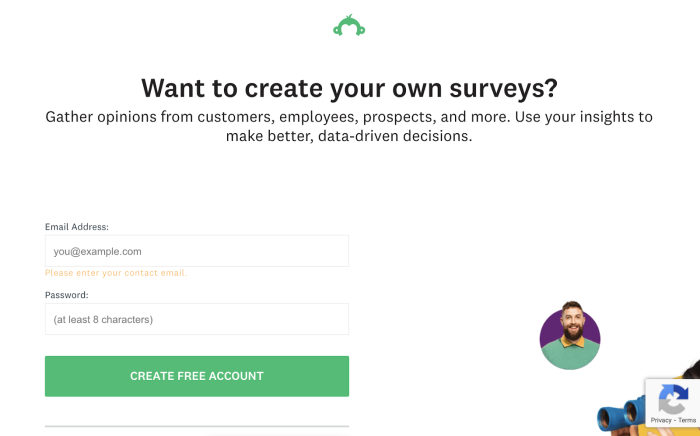
Actually, that’s just what Company 2 is looking for, they want to improve their user experience by collecting feedback too—they sign up.
Now we’re looping. Each customer of SurveyMonkey brings in a percentage of new customers with low effort—who go on to bring in even more customers with very little effort from SurveyMonkey.
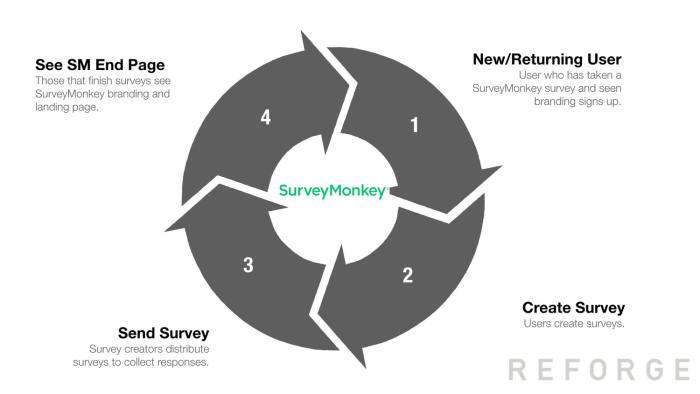
Pinterest’s Growth Loop
Say you’re looking for a carrot cake recipe, you go to Google and type it in and you start drooling immediately. One website that’s guaranteed to be there is Pinterest.
Pinterest uses growth loops to get people to their site with user-generated content that is unblocked by creating an account with them. From there, you tell Pinterest what you like and what you want to see more of e.g., cake. It’s the perfect example of community-led growth.
Your feed is then filled with content that is chosen for you and by interacting with the content, you help Pinterest to find high-performing content. With this information, Pinterest goes on to package this content for search engines, which in turn, brings in more customers.
This is a great loop to bring to your PLG company. You can experiment with user-generated content that goes on to bring in more customers.
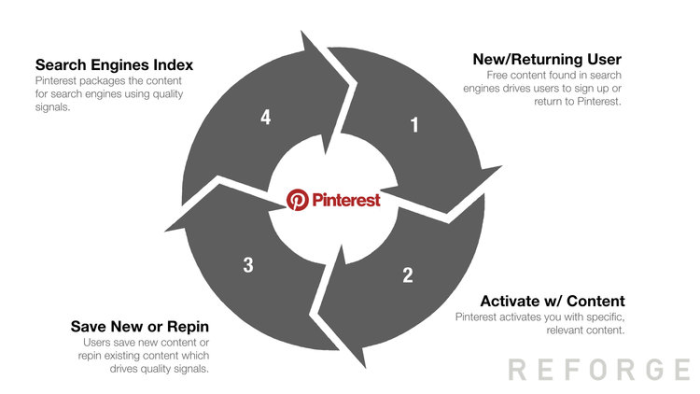
Why you should use growth loops
Every growth loop has its own purpose, and one company can have many loops—some that even loop into each other, loopception. The best thing about them is that they sell themselves. After you’ve set them up, your product is the thing that does the heavy lifting.
In the case of Dropbox, Transferwise, and Uber, users are encouraged to distribute invites to the app to benefit themselves (free storage, free $$$, free rides) – these products acquire users on autopilot and their viral growth track records have made smart B2B companies adopt the same approach.
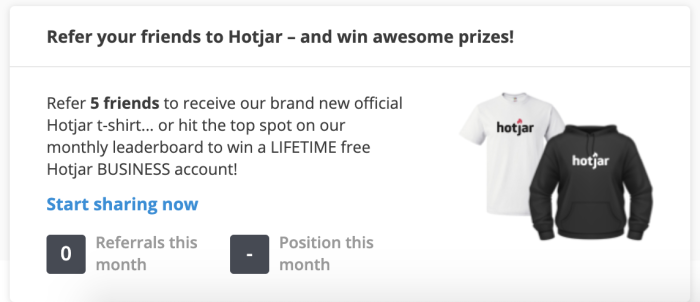
Hotjar incentivizes its users to spread the word with free swag. They gamify the referral process by rewarding their monthly top referrer with a free lifetime membership which you can track on their leaderboard, all you have to do is share a personalized link to their website which is easily done through social networks—big prize + little effort = a virality masterpiece.
The Hook PLG Model
Is your product habit-forming?
Many products don’t lend themselves to be habit-forming. For example, business insurance, or set-and-forget enterprise software on a server farm somewhere. These products need a one-time sale, not a habit.
“Every habit-forming product addresses some kind of uncomfortable emotional state that we seek to escape from. Our brain is good at pattern matching and this is the heart of it. Lonely? Facebook. Uncertain? Google. Bored? Reddit, YouTube, Pinterest.”
– Nir Eyal, author of "Hooked" and "Indistractable"
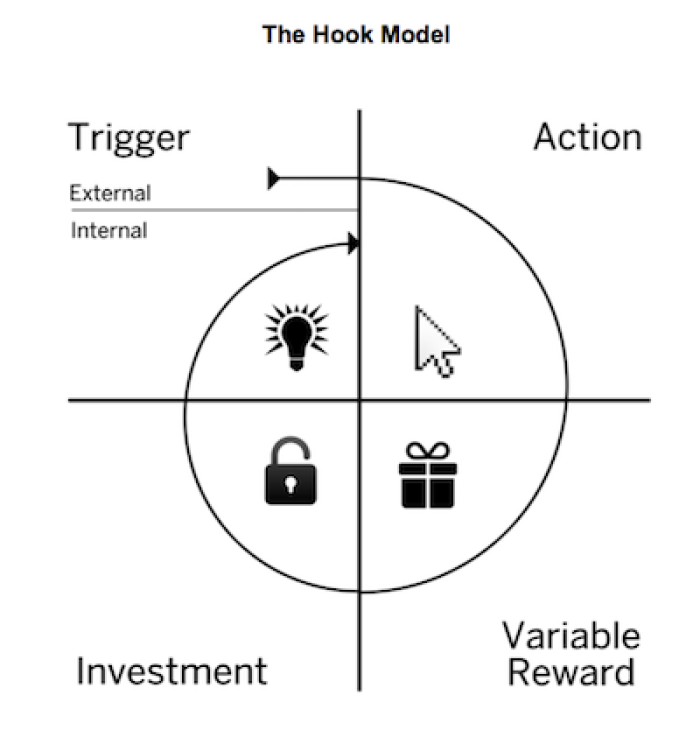
Enter the Hook Model, pretty self-explanatory—it’s designed to hook customers in. This habit-forming strategy is made up of four key phases that are repeated:
The Trigger
The Action
The Variable Reward
The Investment
So how do these work in practice?
Phase 1: The Trigger
This phase can be grouped into two triggers: external and internal.
An external trigger could be a social ad, a billboard, or even looking out the window and seeing rain clouds and then remembering you need to buy an umbrella.
An internal trigger is harder to pin down as it’s an emotion or feeling that your user has—it’s pretty difficult to know when your customer is hungry, bored, or overwhelmed.
Phase 2: The Action
At this point, your user looks to find a solution to their problem or their ‘trigger’.
Say their trigger is feeling overwhelmed at work. They have countless emails coming in with tasks, half their tasks on a Google Doc and the other half scribbled down on a scrap of coffee-stained paper.
Time to make a change. The action they take could be doing a Google search for a ‘to-do list tool’.

The action is complete and they are presented with a potential solution. In this case, it’s monday.com.
Phase 3: The Variable Reward
Now we come to the reward aka ‘the hook’. Has the user got what they came for—and more?
Going back to our poor worker with notes all over the place. They wanted something to help organize their to-do list, but they’ve found even more than what they wanted.
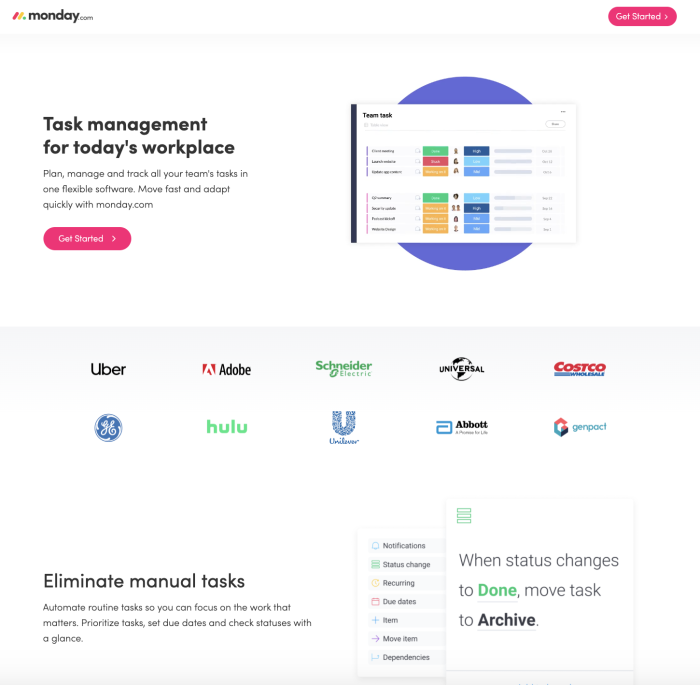
The ad they clicked led them to a product-led landing page that meets the intent—and some.
✅ “Task management for today’s workplace” e.g. a modern solution (we all want to be up-to-date)
✅ “Plan, manage and track all your team's tasks in one flexible software”—you get more than you came for, you could trash all the tattered notepads in the office and get the whole team onboard
✅ “Eliminate manual tasks”—this gives so much more than any old to-do list, it’s going to save you time as well
✅ Social proof shows that this solution is real and trusted
The reward is quick to achieve as well. There’s a clear “Get Started” button which leads you to an easy signup process—you can even see the reward that awaits you behind the form.
Hooked.
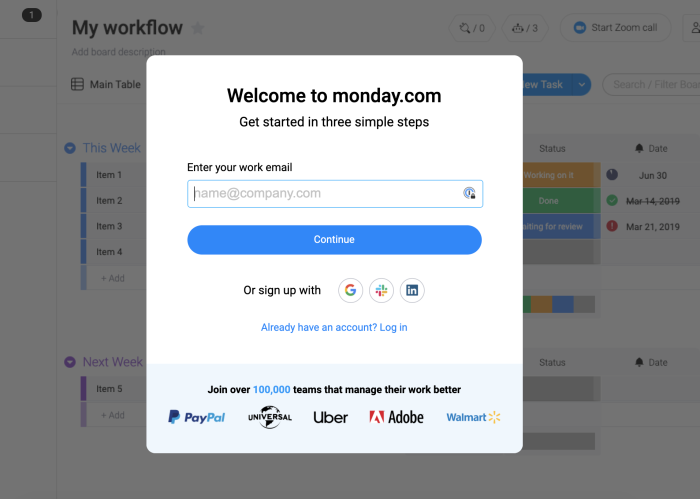
Phase 4: The Investment
The final phase is also the one that sets off another round of the Hook Model.
In the case of monday.com, the investment would be adding your colleagues to the platform, who then go on to reap the rewards, and eventually, you need to increase your plan. The habit is formed within the entire team.
And investment can come in other forms too. It could be leaving a G2 or Trustpilot review to share your experiences—which in turn, encourages others to take action and sign up. In the case of Airtable, it’s gaining credits whenever you invite someone to the platform which you can cash in for paid plans.
The Hook Model dictates that a Product team should look at what the customer is currently doing to solve the problem, then figure out how the solution can solve that problem in a real way. Not just functionally, but based on real needs and emotions.
BJ Fogg Behavior Model
This model is key to your PLG strategy. It’s a way of tying together user onboarding best practices, user engagement, and product design.
The BJ Fogg Behavior Model in 2 minutes and 30 seconds
What is the BJ Fogg behavior model?
It draws upon three key factors that in turn, determine user behavior.
Ease of use (someone's capability to perform a behavior)
Value proposition (someone's motivation to perform that behavior)
Prompts (triggers and nudges for them to perform that behavior)
Applied to products, the BJ Fogg Behavior Model theorizes that the likelihood a user will take the desired action depends on a combination of motivation, ability, and prompts. In the model, you can see these three factors in action:
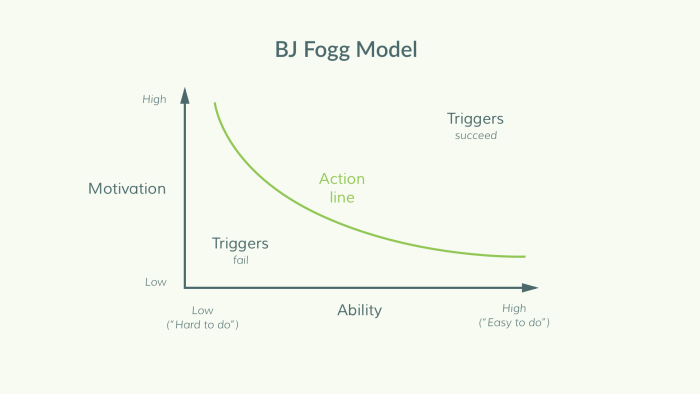
The interface axis is the ease of use. Is your product easy to use or confusing?
The value proposition axis is all about how well your company is defined—how well does it match market needs?
The prompts are reminders and instructions on how users can use your product. If your prompts do the job and trigger your users to take the right action at the right time, you end up in the “engagement” area. If not, you fall below the curve.
How the BJ Fogg behavior model can help PLG strategy
The BJ Fogg model helps a product-led growth framework by emphasizing the importance of onboarding for users. When customers become fully engaged with the product and are prompted to do the right things at the right time, they stay for long as they understand the value that the product brings better. Similar to the Hook model, they find their reward and become more invested.
Take the key principles of the BJ Fogg model into your product-led growth strategy.
Solidify your value proposition
Know who you’re talking to and why they need you. What makes you stand out from the crowd?
The SEO tool Ahrefs, changed their homepage to focus on a well-known pain point for them, that SEO can be intimidating, to begin with. Their original value proposition spoke to people who already knew what they were looking for.
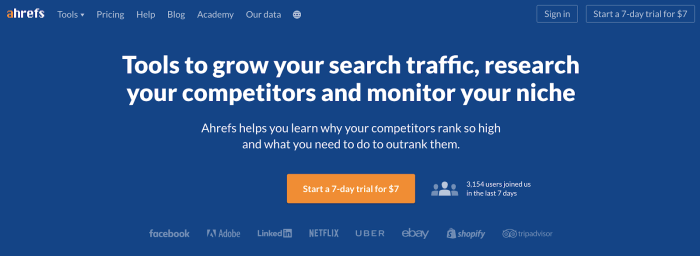
It did the job, but there was room for more. Using a PLG approach, their new value proposition focuses on the benefit, “rank higher and get more traffic”. Who doesn’t want that?
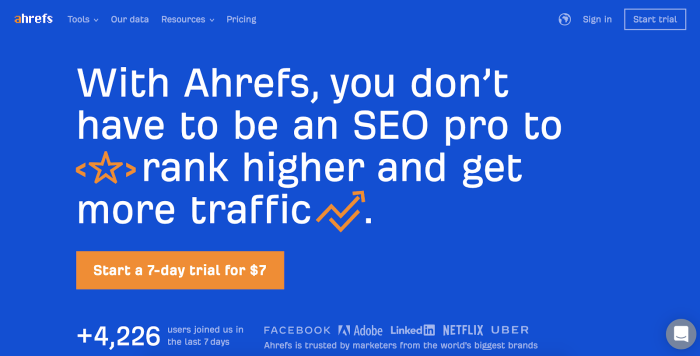
Consistently communicate the benefits of your product
Keep customers for the long haul by reminding them why they should keep using you. Do you save them time? Has your tool brought them in new leads? How many documents have they made with you? Tell them how they’re doing and gamify the process.
Grammarly does this exceptionally well. With their weekly emails, they tell you how many words you’ve written and how accurate you were. They clearly communicate the value of their tool and in turn, you're prompted to challenge yourself to write more and write concisely with Grammarly e.g. use their tool even more.
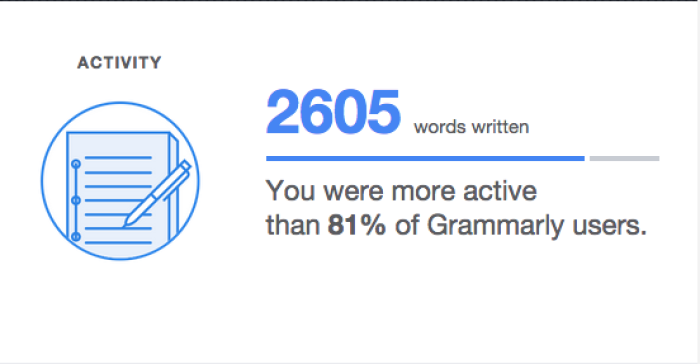
Onboard users like a pro
A thorough and clear onboarding is essential for product led customer success. After you sign up for a new product it can be overwhelming to see all these new features which you don’t have a clue what to do with. Go further than just showing someone a video on how to use it all. And don’t say that your product is intuitive. Show users this is the truth.
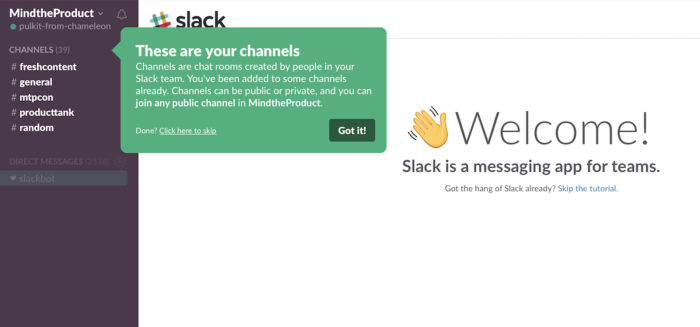
Use product tours to walk your new customer through how everything works. Explain to them what every part of your product does so that they can use it in a way that genuinely gives them value. Slack does this well by walking users through the platform so they can get value ASAP.
The result? They found that by the time a team had sent over 2000+ messages, 93% were stuck with the product.
🚀 Interested in how the BJ Fogg model can help you educate your new users? Check out our guide on sophisticated onboarding.
Prompt at the right time
Keep customers motivated by using prompts. You can use these to form habits or to upsell additional pro features.
But beware of prompting at the wrong time and falling below that engagement curve. Don’t try and get someone to pull out their credit card on your product's welcome page, and likewise, don’t explain how the team accounts work when the whole marketing team has been using the tool for six months already.
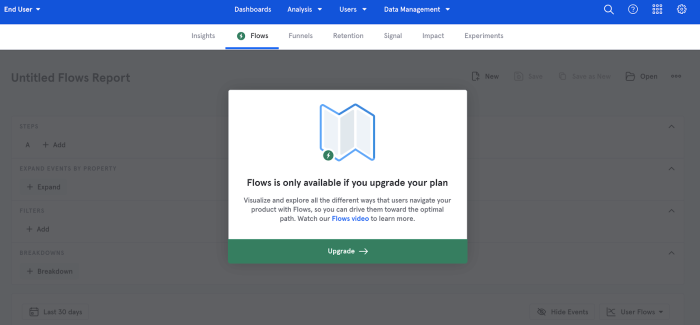
One great way to use prompts is to gate premium parts of your product behind them. In this example, Mixpanel uses a prompt to show the user that a certain feature is only available by upgrading. They reduce friction in the experience by explaining clearly what this feature can do to help you and they offer additional educational resources.
RICE (for prioritization of experiments)
So many ideas, so little time. How do you get started with all your new PLG ideas and finally run those in-product experiments? Prioritization is your friend.
What is RICE?
RICE is a framework used for prioritizing your backlog of product launches, updates, and experiments.
Product managers use this to make well-informed decisions, reduce bias when making decisions, and help them show the why behind their priorities to other key stakeholders.
With RICE, your ideas are ranked depending on the Reach, Impact, Confidence, and Effort.
Reach: This is the number of people you think your experiment will reach. If you’re rolling out a new feature to 1000 customers, then your reach is 1000. But if you’re aiming for this new feature to make 40 of those 1000 customers upgrade, your reach will be 40.
Impact: Whether it's qualitative or quantitative, the impact will help you prioritize your experiments. With the RICE model, you give the impact on the following scores:
3 = massive impact
2 = high impact
1 = medium impact
0.5 = low impact
0.25 = minimal impact
Confidence: Do you have a gut feeling about your experiment or is it backed up by data and you’re totally confident it’s going to be a game-changer? Your confidence score is a percentage that should be somewhere between 50% to 100%. Any lower than 50% and you should be reconsidering the whole experiment, it could be a shot in the dark.
Effort: Will this take up a sprint or a quarter? This effort score should be made up of “person-months”. So, if you have 2 designers working on it for 2 weeks, that’s one month. Your effort score = 1. If you have an engineer working for one month, a copywriter on it for 1 week, and an analyst for 1 week, your effort score would be 1.5. Smaller projects under one month should be noted down as a 0.5, always.
Your overall RICE score will be calculated as follows:
(Reach x Impact x Confidence) / Effort
Load those scores into a Google Sheet or an Airtable to have a complete overview and start deciding on your experiments.
How can RICE prioritization help with PLG?
Using the RICE system, you can effectively juggle both product improvements with PLG machines and loops. Without it, you’ll be going round in circles deciding which is more important.
The PLG loops fuel the product, but the product won’t meet the expectations of the user if it’s not worked on too. It’s a bit of a ‘what came first, the chicken or the egg?’ scenario.
The RICE system helps you see things through a new perspective—and that will help you tonnes when it comes to winning over stakeholders.
What are the benefits of a product-led growth framework?
The list of benefits is long, but for the sake of our wordcount, we’ll keep it short.
Better cross-team collaborations & holistic product development
Siloed teams spring up all too often in SaaS businesses today, and they get no-one anywhere fast. A successful product-led growth framework enables teams to work more collaboratively—sales, marketing, customer success, product development, design; they all come together to work towards a common goal, rather than individual targets.
To better unpick some more of the benefits of a product-led growth framework we spoke to those out in the field today. Here’s what the experts had to say.
Growth without dependencies
PLG means that your business grows without having to invest tens of thousands of dollars on paid advertising or have your sales team constantly calling leads. It’s more efficient and scalable, and will see lower customer acquisition costs. When your strategy is product-led, monetization becomes much easier as Matt Bilotti from Drift points out:
“Product-led growth is building your product in a way that allows you to monetize and grow without needing a sales and marketing organization to scale at the same rate.”
– Matt Bilotti, Product Lead, Growth & Lifecycle @ Drift
Truly customer-centric products
What would a product be without happy customers? Clue: non-existent.
Product-led growth is all about creating delighted customers who become your biggest fans and go on to promote your business, all on their own accord. Product-led strategies lead to Improved customer satisfaction scores (CSAT) and net promoter scores (NPS)—happy people = happy matrics.
Kelly O’Connell from ActiveCampaign sums up the reason behind it nicely:
“PLG is building a company and driving growth through a product that solves real customer problems. Understanding customers’ needs and pains, driving to build a product that solves those pains, and then aligning the company to support the product and mission.”
– Kelly O’Connell, Director of CXA Innovation and Product Strategy @ ActiveCampaign
Companies that adopt a product-led growth strategy do everything possible to make their product the best out there. They take on customer feedback and actively create new features based upon what their users are asking for—they're 100% customer-centric. And the results speak for themselves:
“Your product becomes the core driver of acquisition, expansion, and retention.”
– Kelly O’Connell, VP of Product Strategy @ ActiveCampaign
Independent product adoption
Having a product that lets your customers self-serve and adopt independently is a huge factor for PLG. This means that product-led models help increase retention and beat churn. Erin May from User Interviews told us how the key lies in in-product discoverability:
“Product-led growth is about getting more out of your product builds by making sure users can discover features and use cases that will activate them (help them first find value), keep them engaged (retained) for the long haul, and better monetized (e.g. making sure you have the right value metric, and that it can be monetized in a self-serve way).”
– Erin May, VP of Growth & Marketing @ User Interviews
Giving your users the ability to onboard themselves to your tool on their own is key to product-led growth. Of course, help is always at hand when needed. But lowering the barrier to adoption truly makes that “aha” moment come quicker. For Eric Peters at Hubspot, product-led growth is all about independent adoption:
“PLG is an evolution driven by consumer behavior to change prospect and customer experiences from interactions between humans to more scalable self-service interactions with technology.”
– Eric Peters, Product Manager, HubSpot Academy @ HubSpot
Non-committal pricing
PLG is usually fueled by a freemium-based pricing model. The reason being people can get started on their own and interact with the tool without committing to a monthly or annual fee. It also allows companies who are small but growing to get started for free, with the view that they’ll commit to paying at the right time. Gen Furukawa from Retainable puts it this way:
“A product-led growth strategy enables users to explore the product for themselves without the restraint of features, and come to their own conclusion on the value that the product delivers. Pricing is one of the most important levers for PLG—the shift from demo and sales to free trial or freemium.”
– Gen Furukawa, CEO @ Retainable
Perhaps you’re thinking: “hang on a minute. Are we still learning about B2B SaaS here?” A Lot of these benefits seem suspiciously familiar… Truth be told, we are still talking about B2B SaaS—it’s just looking very different today. In fact, selling B2B SaaS is now likened to selling B2C mobile apps. Read on.
H3: Selling B2B SaaS like B2C mobile apps is a more innovative strategy
While B2C apps are a walk in the park to sell, B2B it’s more complex.
Take a standard fitness tracker app you might have on your phone. The benefit here for you is clear and simple—download the app, get insights into your physical health as you give it more information, improve your fitness and overall diet/ become Thor’s body double.
Now B2B is tougher. Historically it has come with a high barrier to entry, a ramp-up period, and a strong need for executive buy-in. But all that is changing.
With product-led B2B products, we’re now seeing a shift towards tactics used by B2C apps:
Google logins
free to get started
invite who you want to join
Triggers in the product, like account limits or upgrade offers, are so much more powerful than triggers in the external world—CS upsell consultation, automated emails, push notifications.
“No one’s getting addicted to SaaS software. People use it because they want to, not because they have to.”
– Nir Eyal, author of "Hooked" and "Indistractable"
PLG is paving the way for a new type of SaaS.
Futuristic SaaS is product-led
No more afternoons at the golf course, it’s all about PLG these days.
“The buying process has shifted to focus on the buyer—their experience, their needs, and their stage in a lifecycle. Buyers want to self-educate, see ‘behind the curtain’, and ultimately lean to representatives more for clarity or additional service.”
– Kelly O’Connell, VP of Product Strategy @ ActiveCampaign
PLG SaaS scales and sells itself. It also lets customers take control of how they incorporate the product into their stack.
A Product-led growth framework makes this grow scalable. The cost of serving an online product to far-flung corners of the globe is no higher than giving access to a local customer.
With a sales-led approach and no international team, selling to customers in opposite time zones can be a challenge.
What’s more, personalized experiences sell. And, technology and AI now enables personalization instantly and at scale. Based on data collected in the onboarding process, products can offer relevant content and smart defaults that reduce friction and showcase the features that’ll get customers to “aha!” quicker, and make a convincing case for why they’re using the right tool for the job.
Personalized onboarding with Airtable
One SaaS company that stands out here for its personalized onboarding is Airtable.
After you create your account and put on a free Pro Plan, they ask you to answer a few short questions to give you the ultimate onboarding experience. One of them being, “What will you use Airtable for?”
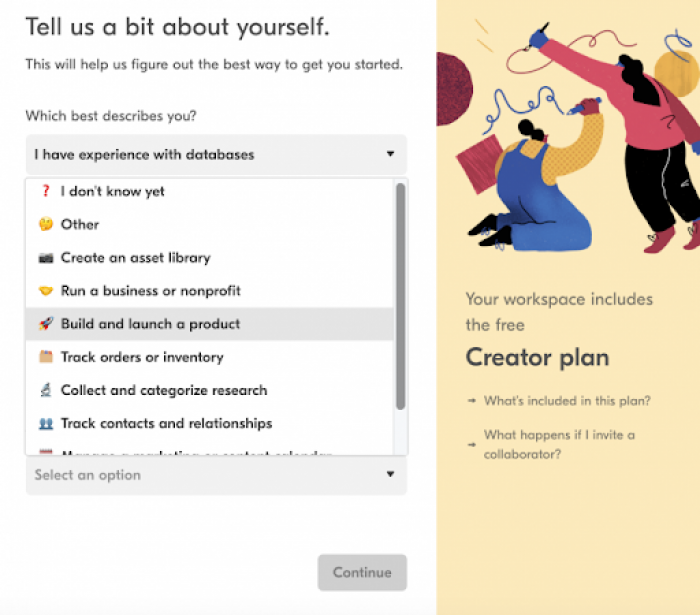
After you tell them about what you’ll be using the tool for, you’re met with a Workspace that’s filled with databases that are relevant to your use case. In this case, our Workspace is filled with inspiration to launch a product with Airtable.
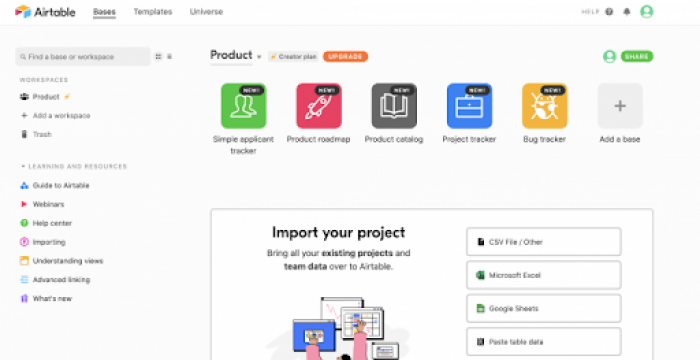
Intimidated? Not at all. Each airtable within the Workspace is filled with dummy data allowing you to reverse engineer how the tool works as well as handy tooltips. This is a great example of product-led customer success. Any minute of the day, anywhere in the world—you can start launching projects with them.
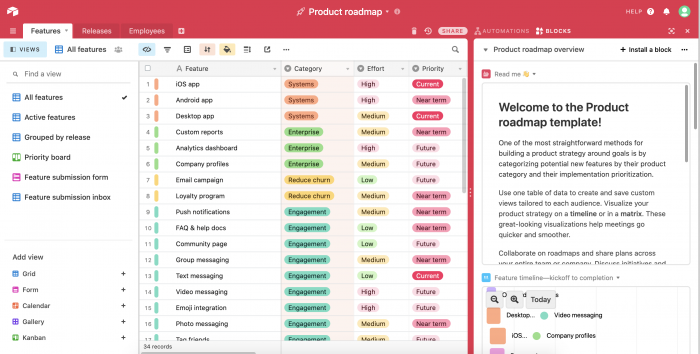
Product-led SaaS automates customer success inside the product. Traditionally, SaaS companies have run customer success with a high-touch approach, focusing on regular check-ins and coaching calls.
Clearly, that won’t scale; bigger SaaS products need bigger CS teams to bridge the gap between signup and success. This has been accepted as an expensive necessity, especially for complex offerings.
Product-led SaaS is optimized to retain customers regardless of whether CS intervenes—simpler workflows, user-centricity and in-line guidance are the focus instead. When CS runs on autopilot inside the product, there’s more to spend on must-have features and improvements. And, releasing must-have features can have the exact same effect: stickiness.
How to implement a product-led growth strategy
It’s fairly easy to be convinced that product-led growth is the way forward, but how do you go about acting on this effectively? There are a few components:
Setting PLG as a goal
Defining roles and responsibilities
Doing a product audit
Implement analytics tracking
Running experiments
Measuring, learning, repeating
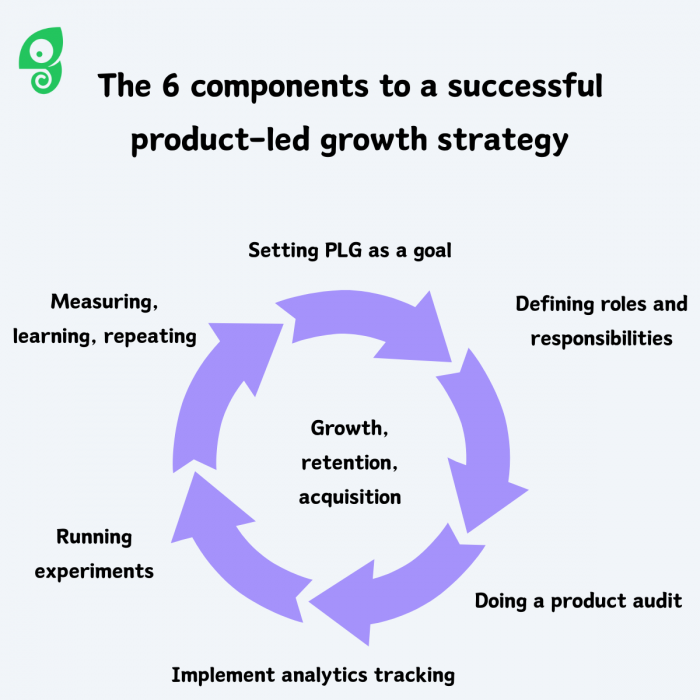
But before we dive into implementing a PLG strategy at your company. There’s a huge point we need to cover—getting buy-in from your team.
The journey to becoming product-led starts with executive alignment that product-led growth is a critical strategy towards product and company success. Without the company leadership encouraging this approach, it will be hard to allocate time, resources, and cycles towards making product improvements, running experiments, and hiring people that will deliver PLG.
Product teams are overloaded with feedback, trying to prioritize and help the users and company. Successfully positioning PLG as the solution and getting traction for implementation needs to come with an awareness of the team’s goals and knuckling down on unified product-led growth metrics. As Mario Araujo from OutSystems told us:
“Acquire people into the movement by creating a powerful narrative with an extremely clear North Star metric. We refined our narrative around PLG to make it clear, easy to understand, and fully tied to customer goals. Today we have teams that are reorganizing to join the movement”
– Mario Araujo, Director of Product Growth at OutSystems.
Once you get all the team onboard, you’ll need to establish open communication between everyone. Break down the silos and create a #PLG group on Slack where you can all share ideas and progress. Here’s how they do it at OutSystems:
“Every six weeks we share our product-led learnings, successes, and failures in a meeting open to all departments. Critical to success was support from the CRO, but the general approach should be bottom-up. We needed buy-in from development and marketing teams, not just higher-ups. Bring someone in from the outside to evangelize to the key teams involved.”
– Mario Araujo, Director of Product Growth at OutSystems.
Now we’ve covered that, let’s get to these six steps.
1. Setting product-led growth as a goal
Now you’ve got buy-in, it’s time to lay down some goals for PLG. Setting goals proves impact and enables continued cross-functional work towards growth.
You can leverage the OKRs to consider setting some product-led growth goals for your next quarter.
For example, let's say that the objective is to successfully launch feature Y. In that case, key results could be:
KR1: Identify key product actions that indicate the best-fit user persona through experimentation
KR2: Create friction logs for key actions and flows
KR3: Rollout new product tour to 50% of users pre-launch
KR4: Boost signup to paid conversion rate by 3%
2. Defining roles and responsibilities for executing product-led growth
Without clear ownership and accountability, it’ll be hard to execute any product-led growth strategy. You don’t need to hire new people for this; instead, you can identify an individual or a team from within your organization that can lead your PLG efforts.
Great candidates for this individual or team include:
Product managers with growth or funnel conversion experience (e.g. improving trial conversions, increasing activations, creating upsell opportunities, etc.)
Designers who are analytical and have experience with experimentation
Engineers who have worked on growth or experimentation
Product Marketing or Customer Success Managers that have a good sense of UX design and/or strongly understand the market and customers
Anyone that’s had experience scaling a B2C product
We recommend setting up a pod or squad to lead PLG with this team recipe:
1 PM
0.5 design
1 engineer
0.5 product marketer
0.5 customer success/support
0.25 BI/Analyst
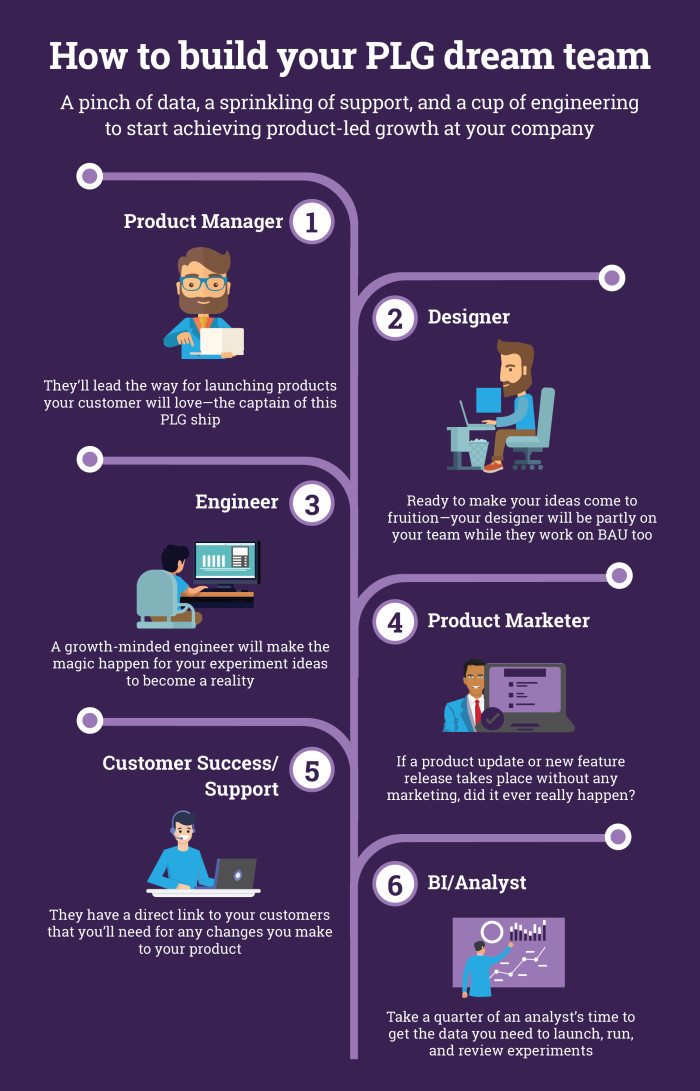
This structure is lighter on engineering than a typical product team because a lot of tools now enable experimentation without heavy engineering lifting.
3. Doing a product audit for opportunities
Once you have some folks looking into product-led growth, then the question arises of “Where do we begin?”. There are some more obvious flows that you can consider:
Trial experience/conversion to paid
Activation (especially if this happens post-payment)
Churn deflection/reduction
Upsell (more usage, or different plan/product)
To help you decide which leaky funnel to plug first, we’d recommend one of two approaches:
Assess your conversion metrics against benchmarks from your industry
Assess opportunities across the whole product and prioritize based on ROI
The first approach is hampered by a lack of appropriate or detailed benchmarks, so whilst some people look for these to guide their decision-making, we recommend not worrying too much about these, and just assessing where the opportunity is greatest for you.
To assess opportunities, here are a few things you should consider doing:
Map out key user journeys (e.g. from sign-up to payment, or from sign-up to activation)
Identify key "aha moments" within these journeys; points of delight where a user finds value and restocks on motivation to continue
Write a detailed step-by-step friction log that identifies each action a user has to take and the associated friction with this
Look at funnel metrics (where you have them) to understand which actions cause the greatest drop-off within a journey
Developing hypotheses on methods to increase motivation and reduce friction. As we explained above, BJ Fogg’s Behavior Model shows that actions are a result of a trigger when a user has sufficient motivation and ability. Therefore the goal for us is to improve motivation and ability e.g. reduce friction.
Translating these hypotheses to specific experiments. These might take various forms, such as:
UI change (e.g. making a button more prominent)
Explanation of copy/taxonomy (with explainer text or a tooltip)
In-product Experience (e.g. a prompt to help a user make a decision)
Flow change (different order of steps needed)
4. Implement analytics tracking
To enable product-led growth it’s absolutely critical to have the data to make decisions. This requires sufficient instrumentation so that you can know and understand what users are doing (and why).
“Teams don't know what to capture, so they try to capture everything. Boiling the ocean makes it hard to understand what's important or validate the integrity of your data.”
– Patrick Thompson, CEO & Co-Founder @ Iteratively
Here are some recommendations for tooling to help with that:
Customer Data Platform, e.g. Segment (this will be the central place from where you instrument and feed data to other systems)
Data Warehouse, e.g. Redshift (this will be where you hold all your data and allow your BI team to run custom queries)
BI or querying tool, e.g. Looker
Data piping tool, e.g. Fivetran
Event analytics tool, e.g. Mixpanel
Event tracking tool, e.g. Iterable
Session Recording tool, e.g. FullStory
NPS/Microsurveys tool, e.g. Chameleon
Here's what Patrick Thompson suggests:
"We recommend starting small and prioritizing the metrics and events you care about. Think of analytics as a feature, ship the MVP, and then continue to invest over time as the data maturity or your organization grows.”
– Patrick Thompson, CEO & Co-Founder @ Iteratively
5. Running experiments
Once you have a list of experiments, it’s important to ensure they are prioritized using the RICE method.
It’s also important to follow best practices.
Be systematic with your experiments. After you’ve committed to which ones you will work on, carry them out in an arranged order—and always test one thing at a time.
Include the team in the planning process. Schedule time with your squad to ensure that all ideas and initiatives are heard.
Kill your darlings. Your favorite idea might not be the one that will drive PLG. Try and keep personal opinions out of the planning process and be brutally honest.
Set expectations with timelines. Know for how long you’re going to run your experiments, and allow for other factors such as low traffic.
Keep metrics at the top of your head. Always focus on what you’re doing around your key metrics, if it’s retention, always come back to what you can do to improve it even more.
6. Measure, learn, repeat
The retrospective is as important as the actual experiment and it’s important to share all learnings—good or bad. Get all the team together and block off a couple of hours to go through the experiment. Try using some of these techniques to keep growing and improving:
Send out a feedback form before the meeting. Ask the team what went well, what didn’t go so well, and what they learned from it all
Encourage a ‘Town Hall’ type of feedback session. Make feedback sessions open and encourage everyone to contribute.
Include remote and in-house team members. A tool like Miro can help everyone to have a say in real-time
Document everything. Find a tool that works for you. For example, you could use Notion to create a space where anybody could go into and know exactly how your experiments are going. Visibility is paramount to PLG.
Take the negatives into your next experiment. Use them to learn and make sure that you don’t make the same mistakes twice.
Simple as A, B, C, 1, 2, 3… 4, 5, 6. What’s that you say? This wasn’t enough!? Not to worry, we saw it coming. Here’s some more reading for you—enjoy the rabbit hole!
Continue learning with these resources for product led growth
We wrapped up the insights and learnings about product-led growth above, together with key frameworks and essential steps to help you start implementing PLG strategy to your own organization.
Want to know more? Keep learning and growing your knowledge with some of our favorite resources.
First up, make sure you watch our on-demand webinar on Product-Led Growth 101 👇

On-Demand Webinar: Product-Led Growth 101 🚀
How can you use PLG to drive acquisition on autopilot? Become an expert in this 60-minute webinar.
ProductLed Institute
Learn about PLG, chat with other product-minded people on their Slack channel, and take your skills to the next level with their certification course.
ProductLed Summit
Over 150 experts speaking about PLG strategies, examples, and theories—on demand. This summit is online every year.
Wes Bush’s Product-Led Growth Framework
An essential piece of viewing for anyone looking to implement product-led growth framework at their company. Wes Bush is one to follow for all things PLG.
OpenView blog
OpenView first coined the term "product-led growth" in 2016. Get advice from product leaders and SaaS founders focused on PLG. Subscribe to the newsletter to get the best tips.
Growth.design case studies
Growth and design case studies in a comic book format plus extra information on the psychology behind product growth.
Hooked: How to Build Habit-Forming Products
This book is essential for anyone looking to learn more about how the Hook model works and how to implement it.
Reforge courses and blog
Reforge launches exclusive courses on an application-only basis. Get a taste of some of their secrets on their blog.
SaaStr talks on Product and Marketing
A wealth of talks and interviews about how to scale your PLG. Here, you’ll find many playbooks to watch with some popcorn.
Product-led growth FAQs
-
1. What are the most important product-led growth metrics to track?
-
Some of the most important product-led growth metrics to track are: customer lifetime value (CLTV), Net Promoter Score (NPS), churn rate (CR), activation rate (AR), monthly recurring revenue (MRR), conversion rate optimizations (CRO), customer acquisition cost (CAC), and average contract value (ACV).
-
2. Can product-led growth answer important challenges for SaaS companies?
-
It can answer a lot of them! Product-led growth can help remedy common challenges like siloed teams, pesky customer churn rates, dodgy retention rates, low NPS scores, and high customer acquisition costs.
-
3.What questions should you ask yourself before deciding on a product-led growth model?
-
Ask yourself if you are willing to put in the time and resources now to get the tools and processes onboard to make a PLG model work. You may need less people in the long run, but to initiate this model you’ll need an all-hand approach, and a budget to match.





